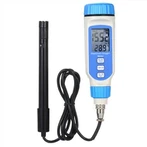Expansion of digital multimeter's capacitance measurement function
Common three-and-a-half-digit or four-and-a-half-digit digital multimeters are equipped with capacitance measurement functions, but the measurement range is narrow and the measurement accuracy is low, and they generally do not have online measurement functions. This article discusses how to extend these capabilities.
1. Online measurement of capacitance
According to the properties of the differential and integral circuit, the measurement of capacitance can be converted into a voltage measurement.
The core part of the circuit, CX/V, uses a simple active RC inverting differential and integrating circuit. The Venturi oscillator generates a fixed-frequency AC signal Vr, which excites the CX/V conversion circuit and obtains an AC voltage V0 (V1) proportional to CX. It is filtered by a second-order band-pass filter to filter out voltages other than the fixed frequency. After the clutter is removed, the DC output voltage V proportional to CX is obtained after AC/DC. When the AC signal Vr excites the CX/V circuit, the output voltage of the inverting integrator
That is, the measured capacitance CX is proportional to the output voltage C0, thereby achieving CX→V conversion. In order to make the basic capacitor range correspond to the 2V range of the digital multimeter, select the oscillation frequency of the Venturi oscillator as 400Hz, the effective voltage value as 1V, R1 as 20kΩ, and C1 as 0.1μF. R2 changes from 200Ω-2kΩ-20kΩ-200kΩ-2MΩ, and the corresponding measurement capacitance range is 20μF-2μF-200nF-20nF-2nF.
2. Measure small capacitance
The general three-and-a-half-digit digital multimeter's measuring range for measuring capacitance is 2000pF ~ 20μF. It is powerless to measure tiny capacitances below 1pF. According to the capacitive reactance method and using high-frequency signals, the measurement of tiny capacitance can be realized. The measurement circuit diagram is shown in Figure 2. CX is the measured capacitance, Rf is the inverting terminal feedback resistor. When the sinusoidal signal Vi with frequency f is input, the impedance presented on CX and the gain of the operational amplifier are: When A and Rf are constant, the sinusoidal signal frequency f is inversely proportional to the measured capacitance CX. To measure smaller capacitances, high frequency signal measurements are used.
The block diagram of the circuit principle for realizing the measurement is shown in Figure 2(b). The measurement process is: the high-frequency sinusoidal signal generated by the high-frequency signal generator is applied to the measured capacitor, CX is converted into capacitive reactance Xc, and then Xc is converted into an AC voltage signal through C/ACV conversion, which is amplified by the amplifier and output by the isolation transformer. It is sent to the phase-sensitive demodulator for demodulation; the other input of the phase-sensitive demodulator is the square wave (i.e., the demodulation signal) generated by the high-frequency sine wave through the waveform converter. The two input signals have the same frequency and phase. The demodulated signal is filtered by a low-pass filter to obtain a DC voltage proportional to the measured capacitance CX value, and is sent to a DC voltmeter to directly display the measurement result. The waveform converter consists of a zero-crossing comparator with an inverting input, which converts a standard 1MHz high-frequency sine wave from a Wien oscillator into a standard inverted square wave. Since the output of the phase-sensitive demodulator is a pulsating DC voltage containing high-frequency harmonics, in order to obtain a stable and constant DC voltage output, a π-type filter is used to filter out the harmonic components. Finally, the corresponding average voltage is sent to the DC voltmeter. In order to make the basic capacitor range correspond to the 2V range of the digital multimeter, the frequency of the high-frequency sinusoidal signal is selected as 1MHz (if the frequency is too high, the distribution parameter must be considered), the effective value of the voltage is 1V, and the product of the circuit amplification factor and the feedback resistor Rf is, so The digital multimeter's DC voltage range of 200mV corresponds to a capacitance range of 0.2pF, and a capacitance range of 200V corresponds to 200pF. The measurement range is 10-4~102pF, and the resolution is 10-4pF.






